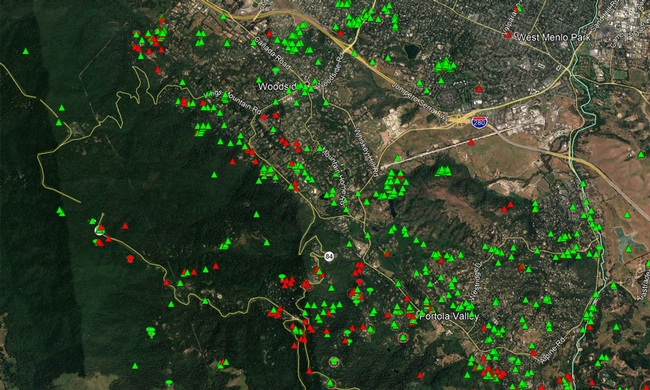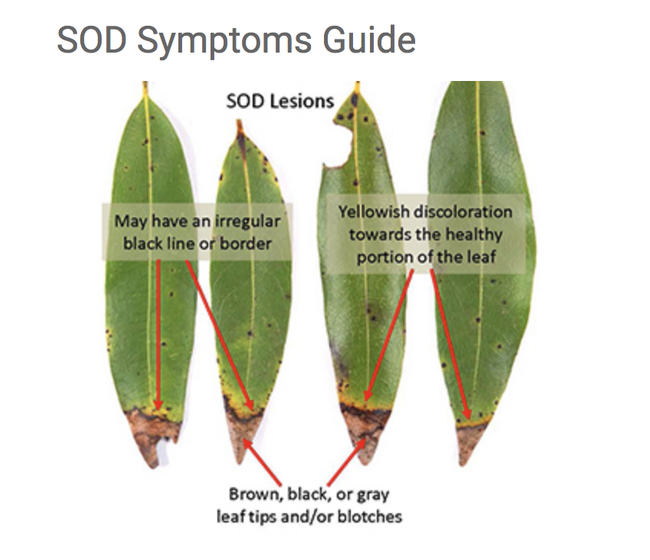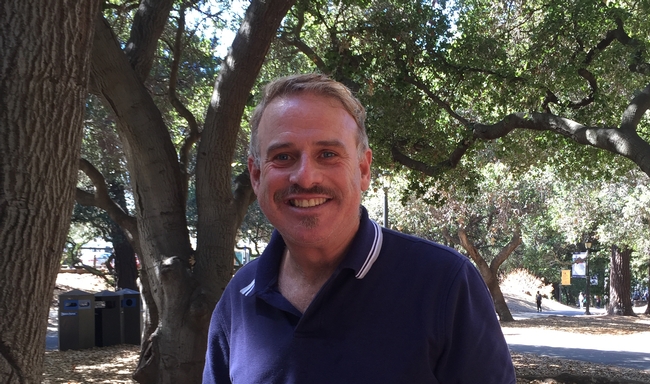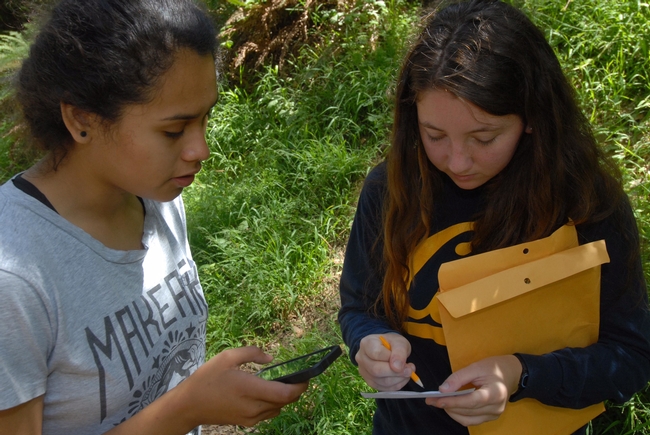Reposted from the UCANR Green Blog
Overall, 3.5 percent of the trees (based on those areas sampled during the blitzes) were found to be P. ramorum positive, a threefold drop from 2017. Yet, in San Mateo, Santa Clara and Santa Cruz counties, infection levels were estimated to be as high as 19 percent, followed by 12.7 percent in the East Bay.
"Oaks and tanoaks were infected last year and will be showing symptoms such as bleeding in the stem and canopy drying this year and in the next two years to follow. Hence, despite a reduction of SOD infection on leaves of California bay laurels and leaves of tanoaks in 2018, we can expect a sharp increase in oak and tanoak mortality in 2018, 2019 and 2020."
Notable outbreaks were detected in Alameda (El Cerrito and Oakland urban parks, San Leandro, Orinda, Moraga), Marin (Novato, Day Island, Woodacre, Sleepy Hollow, McNears Beach, China Camp State Park, north San Rafael, Tiburon Peninsula, east and west peak of Mt. Tamalpais, Marin City), Mendocino (south of Yorkville), Monterey (Carmel Valley Village, Salmon Creek Trail in southern Big Sur), Napa (east Napa city), San Mateo (Burlingame Hills, west of Emerald Hills and south of Edgewood Rd, Woodside ), Santa Clara (Los Altos Hills, Saratoga, Los Gatos, along Santa Cruz Co border), Santa Cruz (along the Santa Clara Co border, Boulder Creek), and Sonoma (near Cloverdale, east and west of Healdsburg, west of Windsor, east of Santa Rosa, west of Petaluma) counties.
Several popular destinations where P. ramorum was found positive during the 2017 Blitz were negative for the pathogen in 2018, including Golden Gate Park and the Presidio of San Francisco, the UC Berkeley campus, and Mount Diablo State Park. Samples from San Luis Obispo and Siskiyou counties were also pathogen-free as were those from the southern portion of Alameda County.
“It is encouraging that SOD has yet to be found in the forests of California's northern-most counties, San Luis Obispo County and southern Alameda County,” said Garbelotto.
“It is also encouraging to see that despite its continued presence in the state for more than 20 years, SOD infection rates drop during drier years,” he said. “However, in 2018, we identified a number of communities across several counties where significant outbreaks were detected for the first time, and the Salmon Creek find in Monterey County is the southernmost positive WUI (wildland-urban interface) tree detection ever. Until the 2018 Blitz, only stream water had been found positive in the Salmon Creek area. We encourage everyone in affected counties to look at the Blitz results online and to attend one of the fall workshops to learn how to protect their oaks from SOD.”
Citizen-science SOD Blitz workshops
SOD Blitz Workshops are being held this fall in Santa Rosa (Oct. 10), Portola Valley (Oct. 16) and Berkeley (Oct. 17). The trainings will discuss Blitz results and recommendations for protecting oaks in the WUI. Workshops are intended for the general public, tree care professionals and land managers (see www.sodblitz.org for details). Two International Society of Arboriculture continuing education units will be offered at each training. Data collected from the Blitz (both positive and negative samples) have been uploaded to the SOD Blitz map (www.sodblitz.org ) as well as to SODmap (www.SODmap.org) and to the free SODmap mobile app, which can serve as an informative management tool for people in impacted communities.
Twenty-five SOD Blitz surveys were held in 2018 in the WUI of 14 coastal California counties from the Oregon border to San Luis Obispo County and included three tribal land surveys. The 304 volunteers surveyed approximately 13,500 trees and submitted leaf samples from over 2,000 symptomatic trees to the Garbelotto lab for pathogen testing.
SOD Blitzes are a citizen science program, which train participants each spring to identify symptomatic tanoak and California bay laurel trees in the WUI and to properly collect samples in the interest of generating an informative map of P. ramorum disease symptoms over time. Samples are tested for the presence of the pathogen at UC Berkeley and results are posted electronically each fall. Now in its eleventh year, the SOD Blitz program is one of the first in the world to join researchers and volunteers in a survey for a tree disease.
SOD Blitz surveys were made possible thanks to funding from the US Forest Service State and Private Forestry, Midpeninsula Regional Open Space District, and the PG&E Foundation. The Blitzes were organized by the UC Berkeley Garbelotto lab in collaboration with the National Park Service, Presidio Trust, San Francisco Public Utilities Commission, Midpeninsula Regional Open Space District, Save Mount Diablo, Land Trust of Santa Cruz County, East Bay Regional Park District, Santa Lucia Conservancy, Sonoma State University, UC Santa Cruz Arboretum, Los Padres National Forest, City and County of San Francisco Department of Recreation and Parks, UC Berkeley Botanical Garden, and California Native Plant Society.
Video of Dr. Matteo Garbelloto describing the three steps to managing sudden oak death.
For information on the status of P. ramorum/SOD tree mortality in California wildlands, see the US Forest Service 2018 Aerial Detection Survey results at https://www.fs.usda.gov/detail/r5/forest-grasslandhealth/?cid=fseprd592767.
For more information on the SOD Blitzes, visit www.sodblitz.org or contact Katie Harrell at (510) 847-5482 or kmharrell@ucdavis.edu. For more information on Sudden Oak Death and P. ramorum, visit the California Oak Mortality Task Force website at www.suddenoakdeath.org or contact Harrell.



